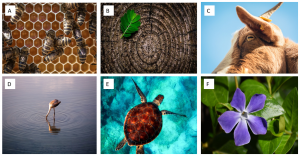KS2 Maths Lessons: Year 3 Maths
Challenge level ⭐⭐
(designed for children with prior knowledge of the Year 3 and Year 4 programme of study)
Learning Objective
We are learning how to recognise and describe the properties of 2-D shapes using accurate language.
Context: shapes in nature
Credit: BBC One - Forces of Nature with Brian Cox
Clip Description
The natural world is full of interesting 2D shapes. Honeycomb cells (A) are hexagonal shaped, as are some of the bony scutes on the shell of a turtle (E). Concentric circles (circles that share the same centre but are different in size) can be found in the rings of trees as they grow and age (B) or in the ripples of a pond or lake (D) when it is disturbed. A periwinkle flower has an almost perfect pentagon at its centre (F) and the pupil of a goat and some other animals are almost rectangular (C).

In this fascinating clip, we are transported to Nepal, where honey hunters scale enormous cliffs to seek out giant beehives. Why do the bees make their waxy honeycomb in a hexagonal pattern? Watch the clip to find out.
Whiteboard Number Challenge
The number 6 has many connections to the natural world such as the six-sided hexagonal pattern of a honeycomb, the number of legs on an insect and the number of corners a snowflake has.
Use this opportunity to rehearse your six times table.

